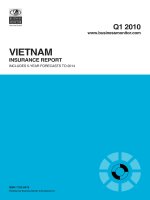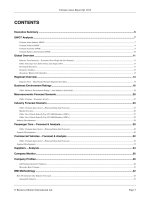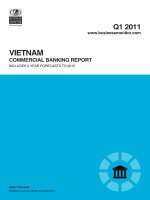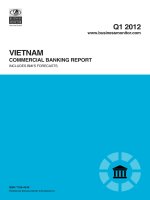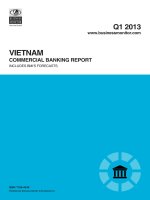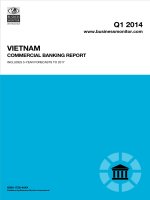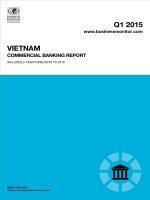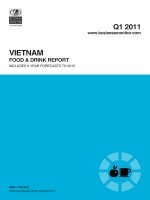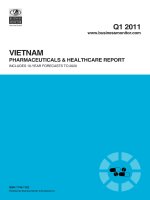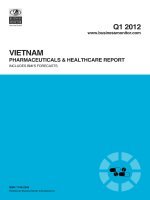Vietnam telecommunications report q1 2016
Bạn đang xem bản rút gọn của tài liệu. Xem và tải ngay bản đầy đủ của tài liệu tại đây (374.73 KB, 74 trang )
Q1 2016
www.bmiresearch.com
VIETNAM
TELECOMMUNICATIONS REPORT
INCLUDES 5-YEAR FORECASTS TO 2019
Published by:BMI Research
Vietnam Telecommunications Report Q1
2016
INCLUDES 5-YEAR FORECASTS TO 2019
Part of BMI’s Industry Report & Forecasts Series
Published by: BMI Research
Copy deadline: December 2015
ISSN: 1748-4944
BMI Research
Senator House
85 Queen Victoria Street
London
EC4V 4AB
United Kingdom
Tel: +44 (0) 20 7248 0468
Fax: +44 (0) 20 7248 0467
Email:
Web:
© 2016 Business Monitor International Ltd
All rights reserved.
All information contained in this publication is
copyrighted in the name of Business Monitor
International Ltd, and as such no part of this
publication may be reproduced, repackaged,
redistributed, resold in whole or in any part, or used
in any form or by any means graphic, electronic or
mechanical, including photocopying, recording,
taping, or by information storage or retrieval, or by
any other means, without the express written consent
of the publisher.
DISCLAIMER
All information contained in this publication has been researched and compiled from sources believed to be accurate and reliable at the time of
publishing. However, in view of the natural scope for human and/or mechanical error, either at source or during production, Business Monitor
International Ltd accepts no liability whatsoever for any loss or damage resulting from errors, inaccuracies or omissions affecting any part of the
publication. All information is provided without warranty, and Business Monitor International Ltd makes no representation of warranty of any kind
as to the accuracy or completeness of any information hereto contained.
Vietnam Telecommunications Report Q1
2016
INCLUDES 5-YEAR FORECASTS TO 2019
Part of BMI’s Industry Report & Forecasts Series
Published by: BMI Research
Copy deadline: December 2015
ISSN: 1748-4944
BMI Research
Senator House
85 Queen Victoria Street
London
EC4V 4AB
United Kingdom
Tel: +44 (0) 20 7248 0468
Fax: +44 (0) 20 7248 0467
Email:
Web:
© 2016 Business Monitor International Ltd
All rights reserved.
All information contained in this publication is
copyrighted in the name of Business Monitor
International Ltd, and as such no part of this
publication may be reproduced, repackaged,
redistributed, resold in whole or in any part, or used
in any form or by any means graphic, electronic or
mechanical, including photocopying, recording,
taping, or by information storage or retrieval, or by
any other means, without the express written consent
of the publisher.
DISCLAIMER
All information contained in this publication has been researched and compiled from sources believed to be accurate and reliable at the time of
publishing. However, in view of the natural scope for human and/or mechanical error, either at source or during production, Business Monitor
International Ltd accepts no liability whatsoever for any loss or damage resulting from errors, inaccuracies or omissions affecting any part of the
publication. All information is provided without warranty, and Business Monitor International Ltd makes no representation of warranty of any kind
as to the accuracy or completeness of any information hereto contained.
Vietnam Telecommunications Report Q1 2016
CONTENTS
BMI Industry View ............................................................................................................... 7
SWOT .................................................................................................................................... 8
Industry ................................................................................................................................................... 8
Industry Forecast ................................................................................................................ 9
Latest Updates ......................................................................................................................................... 9
Structural Trends ..................................................................................................................................... 9
Table: Telecoms Sector - Historical Data & Forecasts (Vietnam 2012-2019) . . . . . . . . . . . . . . . . . . . . . . . . . . . . . . . . . . . . . . . . . . . . . . . . . . . . . . . . . . . . . . . . . . . . . . . . . 13
Industry Risk/Reward Index ............................................................................................. 15
Table: Asia Pacific Telecoms Risk-Reward Index - Q116 . . . . . . . . . . . . . . . . . . . . . . . . . . . . . . . . . . . . . . . . . . . . . . . . . . . . . . . . . . . . . . . . . . . . . . . . . . . . . . . . . . . . . . . . . . . . . . 17
Market Overview ............................................................................................................... 19
Market Drivers & Trends ......................................................................................................................... 19
Mobile ................................................................................................................................................. 20
Table: Vietnam Mobile Market ('000) . . . . . . . . . . . . . . . . . . . . . . . . . . . . . . . . . . . . . . . . . . . . . . . . . . . . . . . . . . . . . . . . . . . . . . . . . . . . . . . . . . . . . . . . . . . . . . . . . . . . . . . . . . . . . . . . . . 21
Table: Value-Added Services . . . . . . . . . . . . . . . . . . . . . . . . . . . . . . . . . . . . . . . . . . . . . . . . . . . . . . . . . . . . . . . . . . . . . . . . . . . . . . . . . . . . . . . . . . . . . . . . . . . . . . . . . . . . . . . . . . . . . . . . . . . 24
Wireline Voice & Broadband .................................................................................................................... 25
Pay TV ................................................................................................................................................. 29
Regulatory Development .................................................................................................. 33
Regulatory Overview ................................................................................................................................ 33
Table: Vietnam - Regulatory Bodies And Their Responsibilities . . . . . . . . . . . . . . . . . . . . . . . . . . . . . . . . . . . . . . . . . . . . . . . . . . . . . . . . . . . . . . . . . . . . . . . . . . . . . . . . . . . . . . 33
Legislation And Market Liberalisation ....................................................................................................... 33
Regulation ............................................................................................................................................ 34
Licensing And Spectrum .......................................................................................................................... 34
Competitive Landscape .................................................................................................... 37
Table: Key Players . . . . . . . . . . . . . . . . . . . . . . . . . . . . . . . . . . . . . . . . . . . . . . . . . . . . . . . . . . . . . . . . . . . . . . . . . . . . . . . . . . . . . . . . . . . . . . . . . . . . . . . . . . . . . . . . . . . . . . . . . . . . . . . . . . . . . . 37
Table: Vietnam Mobile Market Overview . . . . . . . . . . . . . . . . . . . . . . . . . . . . . . . . . . . . . . . . . . . . . . . . . . . . . . . . . . . . . . . . . . . . . . . . . . . . . . . . . . . . . . . . . . . . . . . . . . . . . . . . . . . . . . 37
Company Profile ................................................................................................................ 38
Vietnam Posts & Telecommunications (VNPT) ..............................................................................................
MobiFone ..............................................................................................................................................
VinaPhone .............................................................................................................................................
Viettel ...................................................................................................................................................
S-Fone ...................................................................................................................................................
FPT Telecom ..........................................................................................................................................
38
43
47
51
56
59
Demographic Forecast ..................................................................................................... 62
Table: Population Headline Indicators (Vietnam 1990-2025) . . . . . . . . . . . . . . . . . . . . . . . . . . . . . . . . . . . . . . . . . . . . . . . . . . . . . . . . . . . . . . . . . . . . . . . . . . . . . . . . . . . . . . . . . 63
Table: Key Population Ratios (Vietnam 1990-2025) . . . . . . . . . . . . . . . . . . . . . . . . . . . . . . . . . . . . . . . . . . . . . . . . . . . . . . . . . . . . . . . . . . . . . . . . . . . . . . . . . . . . . . . . . . . . . . . . . . . 63
© Business Monitor International Ltd
Page 4
Vietnam Telecommunications Report Q1 2016
Table: Urban/Rural Population & Life Expectancy (Vietnam 1990-2025) . . . . . . . . . . . . . . . . . . . . . . . . . . . . . . . . . . . . . . . . . . . . . . . . . . . . . . . . . . . . . . . . . . . . . . . . . . . . 64
Table: Population By Age Group (Vietnam 1990-2025) . . . . . . . . . . . . . . . . . . . . . . . . . . . . . . . . . . . . . . . . . . . . . . . . . . . . . . . . . . . . . . . . . . . . . . . . . . . . . . . . . . . . . . . . . . . . . . . 64
Table: Population By Age Group % (Vietnam 1990-2025) . . . . . . . . . . . . . . . . . . . . . . . . . . . . . . . . . . . . . . . . . . . . . . . . . . . . . . . . . . . . . . . . . . . . . . . . . . . . . . . . . . . . . . . . . . . . 65
Glossary ............................................................................................................................. 67
Table: Glossary Of Terms . . . . . . . . . . . . . . . . . . . . . . . . . . . . . . . . . . . . . . . . . . . . . . . . . . . . . . . . . . . . . . . . . . . . . . . . . . . . . . . . . . . . . . . . . . . . . . . . . . . . . . . . . . . . . . . . . . . . . . . . . . . . . . 67
Methodology ...................................................................................................................... 69
Industry Forecast Methodology ................................................................................................................ 69
Sources ................................................................................................................................................ 71
Risk/Reward Index Methodology ............................................................................................................... 71
Table: Risk/Reward Index Indicators . . . . . . . . . . . . . . . . . . . . . . . . . . . . . . . . . . . . . . . . . . . . . . . . . . . . . . . . . . . . . . . . . . . . . . . . . . . . . . . . . . . . . . . . . . . . . . . . . . . . . . . . . . . . . . . . . . . 72
Table: Weighting Of Indicators . . . . . . . . . . . . . . . . . . . . . . . . . . . . . . . . . . . . . . . . . . . . . . . . . . . . . . . . . . . . . . . . . . . . . . . . . . . . . . . . . . . . . . . . . . . . . . . . . . . . . . . . . . . . . . . . . . . . . . . . . 73
© Business Monitor International Ltd
Page 5
Vietnam Telecommunications Report Q1 2016
BMI Industry View
BMI View: Vietnam has experienced strong uptake of 3G and fibre broadband in recent quarters,
demonstrating the rising inclination towards both mobile and fixed data use. We now hold a more positive
outlook on the adoption of premium services and advanced networks, although the government's
restrictions on 4G rollouts could restrict operators' abilities to meet rising data needs in the short term.
4G Rollout Restrictions - A Downside To Technological Infusion
Vietnam Mobile Market Forecsts
200,000
150,000
100,000
50,000
0
2013
2014
2015e
2016f
2017f
2018f
2019f
Vietnam - 3G & 4G phone subscribers, '000
Vietnam - Cellular Mobile Phone Subscribers, '000
f = BMI forecast. Source: VNTA, BMI
Latest Updates & Industry Developments
■
We are forecasting 156.299mn mobile subscribers by end-2019, for a 162.1% penetration rate. Out of this
number, 43.653 will be 3G/ 4G connections. However, we highlight the figure is distorted by inactive
prepaid subscriptions and multiple SIM ownership.
• Viettel has installed approximately 200 LTE-enabled base transmission stations (BTSs) in the residential
area of Vung Tau City, Ba Ria City and Long Dien District after being granted permission by the
government to conduct 4G trials. Rising data consumption could increase subscribers' appetite for faster
data transmission speeds through 4G, and Viettel is keen to be the first operator to move into the area.
© Business Monitor International Ltd
Page 7
Vietnam Telecommunications Report Q1 2016
SWOT
Industry
Telecoms Industry SWOT Analysis
Strengths
■
Highly competitive mobile sector dominated by the state.
■
Fixed-line penetration levels and internet user rates are high in major urban centres
such as Ho Chi Minh City, Hanoi, Danang and Haiphong.
Weaknesses
■
Dependency on prepaid services exerts strong downward pressures on average
revenue per user (ARPU) levels.
■
Broadband growth continues to be highly dependent on DSL.
■
Digital divide: many rural areas have little or no access to telecommunications
services despite advanced networks being rolled out in larger cities.
Opportunities
■
Government approach to liberalise the telecoms industry could see the entrance of
more foreign investors.
■
Divestiture of MobiFone from Viet Nam Posts and Telecommunications (VNPT) , and
the former's subsequent planned Initial Public Offering (IPO) by 2016 should provide
the impetus for operators to launch better quality services
Threats
■
Geographical challenges to network deployments; nearly one-third of Vietnam's
villages lie in mountainous areas without access to telecommunications
services.Number of inactive mobile subscribers is unknown in what is still a market
that lacks transparency and reliable data.
■
The Ministry of Information and Communication (MIC) will hold off 4G licensing until
2017; delayed introduction of 4G could cause Vietnam to trail behind its peers.
© Business Monitor International Ltd
Page 8
Vietnam Telecommunications Report Q1 2016
Industry Forecast
BMI View: Positive growth rates in 3G and FTTH subscriptions have enabled us to amend our five-year
forecasts upwards. MobiFone's privatisation will bring about more competition in the mobile sector, which
we believe will drive operators to improve the quality of their services - painting an overall positive picture
for the market. However, the government's recent decision to delay the launch of commercial 4G services
till 2017 could mean that Vietnam is unable to exploit the full demand for mobile data over the next couple
of years, and fall behind its regional peers in technological advancement.
Latest Updates
■
3G subscriber growth picked up over the first three quarters of 2015 and has led us to revise our
subscription forecasts upwards this quarter. We believe that 3G subscribers will reach 35.914mn by
end-2015, and reach 43.653mn by end-2019 - accounting for 27.9% of all mobile subscriptions.
■
We have revised upwards our fixed broadband subscription forecasts as well, in light of faster-thanexpected take-up, especially in fibre broadband. According to VNTA data, FTTH connections grew by
380.7% y-o-y to 2.9mn in Q315. Despite this, fixed broadband penetration reached just 7.7% in Q315,
underscoring the potential for strong subscriber growth to continue throughout our 5-year forecast
period. We forecast 7.20mn fixed subscriptions by end-2015, rising to 9.05mn for a penetration of 9.3%
by end-2019.
Structural Trends
Mobile
The VNTA reported that there were 123.7mn mobile subscribers in Vietnam in December 2013, which
increased to 136.15mn at the end of 2014. The Vietnamese mobile market is highly saturated with more
than 130% penetration, but 3G adoption remains low and constitutes only about 30% of the mobile market.
In June 2014, government-owned Vietnam Posts and Telecommunications (VNPT) sold off its mobile
unit MobiFone with a view to entice outside investment. BMI believes MobiFone's impending IPO will
boost competition in the market as well, providing upside to the 3G market.
Strong competition between operators revolves around price, and aggressively low tariff rates have pushed
the Vietnamese mobile industry towards market saturation and declining profitability. Further evidence of a
growth slowdown includes operators such as Viettel and VNPT looking at overseas markets for additional
growth opportunities - VNPT's MobiFone opened a representative office in Myanmar in December 2012.
We do not expect the Vietnamese mobile market to return to double-digit growth. While rural regions
possess growth opportunities, the return on investment is comparatively low due to the need for the highest
© Business Monitor International Ltd
Page 9
Vietnam Telecommunications Report Q1 2016
capital expenditure and lower purchasing power. Instead, we expect operators to focus on generating higher
revenue from existing subscribers by upgrading customers to more expensive services such as 3G. The
change in emphasis is partially due to market saturation and a competitive landscape that has seen a number
of investors leaving, which leaves the remaining operators with greater market shares. However, we
highlight that the headline figure is distorted by inactive prepaid subscriptions and multiple SIM
ownership.
Russia's VimpelCom was the only operator in Vietnam to publish its ARPU data. According to the firm, its
Vietnamese operation, GTEL Mobile (Beeline VN) - renamed as Gmobile - had an ARPU of USD0.9 in
the quarter ended March 2012; unchanged from December 2011, but up from USD0.7 in September 2011.
Prior data is unavailable, which makes it difficult to identify a trend, although we believe Beeline VN's low
ARPU reflected the intense competition in Vietnam's mobile market. Further, VimpelCom has since exited
the market by selling its 49% stake in GTEL Mobile to its local partner.
We believe that VNPT and Viettel have significantly higher ARPU given their higher market share.
Nevertheless, we estimate that the average ARPU level for the Vietnamese market was in the region of
USD4.1 at the end of 2012, given the strong level of competition, high dependency on basic 2G services
and the occasional aggressive pricing promotion. Both MobiFone and VinaPhone raised their 3G tariffs by
25% in April, to bring their prices on a par with competitor Viettel, but we do not believe this will have a
significant impact on ARPUs in the long run. We envisage ARPU levels in Vietnam to continue to decline
over the next five years. Local media reports that 3G tariff rates are lower than that of 2G services reaffirms
our view that competition remains intense. Local media reported in January 2013 that MobiFone has
launched a 3G service package that costs only VND15,000 (USD0.7) a month.
We do not anticipate that the launch of 4G services will immediately lead to higher ARPUs in the country.
Both Viettel and VinaPhone, it would appear, will begin offering 4G data services without any additional
cost to the consumer. It is, nevertheless, possible that the demand for data consumption will grow that may
entail a higher ARPU. However, we do not envision this to be significantly strong in the short term especially with the government's plan to withhold 4G licensing and limit network investments during the
service's trial period.
© Business Monitor International Ltd
Page 10
Vietnam Telecommunications Report Q1 2016
Industry Trends - Mobile
(2012-2019)
200,000
170
150,000
160
100,000
150
50,000
140
0
130
2012
2013
2014
2015f
2016f
2017f
2018f
2019f
Cellular Mobile Phone Subscribers, '000 (LHS)
3G & 4G phone subscribers, '000 (LHS)
Mobile Phone Subscribers/100 Inhabitants (RHS)
f = BMI forecast. Source: VNTA, BMI
Wireline Voice & Broadband
The fixed-line industry is expected to continue its long-term decline trend driven by mobile substation and
VoIP usage. The latest available data from the General Statistics Office (GSO) registered 14.9mn fixed-line
subscriptions in December 2012, down from the 15.5mn subscriptions in 2011.
Our scenario for Vietnam's fixed-line market is that the major players - VNPT, Viettel and EVN Telecom
(which has since merged with Viettel) - continue their rural expansion projects to sustain their fixed-line
subscriber bases. VNPT is already working to boost subscriber loyalty by offering single billing for both
fixed-line and broadband services. However, we believe that the declining demand is convincing them to
channel their capital to more profitable segments such as mobile and broadband. Further, the traditional
fixed-line voice service is also under threat from cheaper alternatives such as VoIP. The declining
subscriber figures indicate the market's
© Business Monitor International Ltd
Page 11
Vietnam Telecommunications Report Q1 2016
Conversely, the number of fixed broadband subscribers increased by 16.5% y-o-y from 5.153mn in 2013 to
6.001mn in end-2014. VNPT and FPT Telecom together account for more than 80% of the fixed broadband
market. This is a pick-up from the 7.9% growth a year earlier.
Despite Vietnamese telecoms companies continuing to deploy broadband services such as fibre-to-the-x,
affordability and coverage remain key concerns in the emerging market. Demand for traditional fixed
broadband services is increasingly under threat from mobile alternatives due to a lower cost structure. While
we believe there will be limited growth potential for the fixed broadband industry in Vietnam in the near
future, we retain an optimistic view in light of Vietnam's growing affluence and expanding middle class. In
fact, fibre-to-the-home (FTTH) subscriber numbers have demonstrated three-digit y-o-y growth in
2014/2015, and achieved 3.1% penetration in September 2015; accounting for almost half of all fixed
broadband subscribers in Vietnam. In addition, next-generation mobile technologies LTE and WiMAX
could cannibalise demand for fixed broadband solutions, companies could generate consumer interest by
introducing bandwidth-intensive services, such as IPTV, or target businesses by offering bundled packages,
such as cloud solutions.
Although the internet user penetration rate is expected to be approaching saturation in major cities and
towns, rural Vietnam remains comparatively untapped as a result of consumers' lower purchasing power.
However, expansion into these areas is costly and the return on investment is not as attractive. Mobile
internet services are a more efficient way to capture customers in rural areas.
We expect the growth rate of the Vietnamese broadband market to decline in the next few years as
consumers opt for mobile alternatives. That said, declining prices of products and services should help the
sector to grow by an average of 5.2% between 2013-2019 to bring the total number of fixed broadband
subscribers in Vietnam to 7.9mn by 2019.
© Business Monitor International Ltd
Page 12
Vietnam Telecommunications Report Q1 2016
Industry Trends - Wireline Sector
(2012-2019)
15,000
10,000
5,000
0
2012
2013
2014e
2015f
Broadband internet subscribers, '000
2016f
2017f
2018f
2019f
Main telephone lines in service, '000
e/f = BMI estimate/forecast. Source: BMI, VNTA, operators
Table: Telecoms Sector - Historical Data & Forecasts (Vietnam 2012-2019)
2012
2013
2014e
2015f
2016f
2017f
2018f
2019f
14,900.0
13,100.0
12,183.0
11,634.8
11,402.1
11,196.8
11,017.7
10,863.4
Main Telephone
Lines/100 Inhabitants
16.5
14.3
13.2
12.5
12.1
11.7
11.4
11.2
Cellular Mobile Phone
Subscribers, '000
135,682.0
123,736.0
136,148.0
140,232.4
144,860.1
148,771.3
153,234.5
156,299.2
150.2
135.4
147.3
150.1
153.4
155.9
159.0
160.7
16,816.0
19,685.0
28,731.0
35,913.8
37,709.4
39,594.9
41,574.7
43,653.4
12.4
15.9
21.1
25.6
26.0
26.6
27.1
27.9
4,775.0
5,153.0
6,000.5
7,200.6
8,280.7
8,694.8
8,868.7
9,046.0
Main telephone lines
in service, '000
Mobile Phone
Subscribers/100
Inhabitants
3G & 4G phone
subscribers, '000
3G & 4G market, % of
mobile market
Broadband internet
subscribers, '000
© Business Monitor International Ltd
Page 13
Vietnam Telecommunications Report Q1 2016
Telecoms Sector - Historical Data & Forecasts (Vietnam 2012-2019) - Continued
Broadband internet
subscribers/100
Inhabitants
2012
2013
2014e
2015f
2016f
2017f
2018f
2019f
5.3
5.6
6.5
7.7
8.8
9.1
9.2
9.3
e/f = BMI estimate/forecast. Source: National sources, BMI
© Business Monitor International Ltd
Page 14
Vietnam Telecommunications Report Q1 2016
Industry Risk/Reward Index
BMI View: BMI's Telecoms Risk Reward Index for Asia Pacific remained largely unchanged this quarter.
Industry Risk scores were not amended this quarter as the regulatory climate in the APAC countries
remained constant. There have been several minor changes to Country Risk/Reward and Industry Reward
scores this quarter, although none have had the effect of altering the country's overall Telecoms Scores. The
exceptions are Taiwan, which rose one position to tie with South Korea in 6th place, and Fiji, which fell by
one place to match Myanmar's unchanged score at 20th place in the rankings.
Country Risks/ Rewards
Laos, which is ranked last out of the 28 countries in terms of overall telecoms score, experienced an
improvement in Country Rewards score from 39.0 to 41.3 as a result of strong GDP growth, which BMI's
country risk team forecasts to average 6.5% per year from 2016 to 2024 thanks to sustained FDI inflows.
However, the country's poor business environment and weak fiscal position pose downside risks to growth,
and the country is in our bottom five in both Industry Risks and Rewards.
Indonesia, which holds its position from last quarter at 11th place, had its Country Risk score increase from
58.4 to 59.2 this quarter. Its Economic Policy Package III will address electricity tariffs and interest rates
that will benefit business activity in the telecoms sector. The downside risk to this is that the decentralised
nature of the Indonesian government poses challenges in policy implementation and the impact of these
stimulus measures will be limited in the short-term.Indonesia's high subscriber numbers and growth informs
its Industry Rewards score of 55.0, one of the highest in the region. However, the prevalence of prepaid
subscribers points towards multiple SIM ownerships, which means that churn rates are high whilst ARPUs
are limited.
Hong Kong's Country Risk score improved on the back of a robust economic performance in Q215, leading
to real GDP growth of 2.6% in H115, despite China's stock market crash and weak external demand
environment. However, our country risk team believes that downward pressures will intensify in H215 and
has downgraded its 2015 and 2016 GDP forecasts. Hong Kong ranks in third in our telecoms ranking, as
favourable economic, political and regulatory environments facilitate investments into the telecoms sector.
On the other hand, Taiwan's Country Risk scores fell from 73.1 to 72.2, as political instability has weighed
on investor confidence, which will choose to postpone their investment decisions until the elections have
concluded. Similarly, Fiji's downgraded Telecoms Score was the result of a fall in Country Risk score by
© Business Monitor International Ltd
Page 15
Vietnam Telecommunications Report Q1 2016
4.2 points to 34.7 because the lack of judicial independence (see 'Enforcement Risks To Persist Despite
Political Stability', September 28).
Nepal's Telecoms Risk score also fell by one point this quarter, as a result of a decrease in Country Risk
scoring. The country's prolonged political instability (which our Country Risk team gives a 43.1 score on
the short-term political risk index, below the regional average of 69.7) and the earthquakes after-effects
have resulted in a less than ideal business climate and subdued consumer demand. The combination of these
factors have informed our Country Risk team's forecast that real GDP will contract by 4.4% in FY2015-16
(July 16, 2015- July 15, 2016)
Developing APAC Countries - Industry Rewards Will Rise With Economic
Growth
Industry Risk and Reward Scores (Q116)
Source: BMI
© Business Monitor International Ltd
Page 16
Vietnam Telecommunications Report Q1 2016
Industry Risks/ Rewards
Malaysia's Industry Rewards score fell from 50.0 to 47.5 this quarter as high mobile penetration (125%)
coupled with falling blended ARPU - brought about by price competition in the prepaid segment - limits
prospects for organic growth. Instead, operators will have to look towards migrating prepaid subscribers
(79% of the mobile market in Q215) on to postpaid plans to raise blended ARPU, and bundle in higher
value products and services
Singapore's Telecoms Score fell by 1 point to 66.2 (67.3 previously) as a result of a downgraded Industry
Risk score from 50.0 to 47.5. The saturated mobile market, penetration of 152%, provides little opportunity
for subscriber growth. In July 2015, the Infocomm Development Authority (IDA) released incentives such
as discounts on the upcoming spectrum auctions in early 2016 and interconnection from the incumbents to
lower the barriers to entry of a fourth mobile operator into the market. If the licensing of a new operator is
successful, there is a high chance that it will lead to downward pressures on ARPU; key contender
MyRepublic had the same disruptive effect on the fibre market.
Taiwan was the only country this quarter to experience a rise in ranking as a result of a boost in telecoms
score, which rose by 1.4 points to 61.8. This improvement was a result of a higher industry rewards score of
55.0, which offset a slight decline in Country Risk score. Taiwan's operators saw a reversal in the general
declining ARPU trend, as a result of subscribers migrating on to 4G networks, which yielded higher ARPUs
for operators (see 'Chunghwa Investments Will Unlock Premium 4G Market', September 22).
Table: Asia Pacific Telecoms Risk-Reward Index - Q116
Rewards
Risks
Industry
Rewards
Country
Rewards
Industry Risks
Country
Risks
Telecoms
Score
Rank
Previous
Rank
Japan
65.0
70.0
80.0
69.2
69.1
1
1
Singapore
47.5
80.0
90.0
76.3
66.2
2
2
Hong Kong
47.5
76.7
90.0
70.7
64.5
3
3
Australia
52.3
80.0
70.0
62.6
63.3
4
4
New Zealand
47.5
72.0
90.0
68.0
62.9
5
5
Taiwan
55.0
57.0
80.0
72.2
61.8
=6
7
South Korea
52.5
63.0
80.0
69.9
61.8
=6
6
Macau
42.5
80.0
70.0
72.2
60.3
8
8
China
60.5
36.7
70.0
81.8
59.3
9
9
Country
© Business Monitor International Ltd
Page 17
Vietnam Telecommunications Report Q1 2016
Asia Pacific Telecoms Risk-Reward Index - Q116 - Continued
Rewards
Risks
Malaysia
47.5
54.0
70.0
68.1
55.6
10
10
Indonesia
55.0
42.7
60.0
59.2
53.4
11
11
India
52.5
32.1
65.0
70.4
52.1
12
12
Philippines
47.5
41.7
60.0
66.1
50.7
13
13
Afghanistan
35.0
66.7
45.0
57.0
47.6
14
14
Mongolia
32.5
51.0
65.0
65.2
46.8
15
15
Brunei
20.0
80.0
65.0
52.7
46.4
16
16
Pakistan
42.8
42.0
60.0
49.2
46.1
17
17
Vietnam
52.3
30.0
30.0
67.4
45.7
18
18
East Timor
25.0
46.7
80.0
64.7
44.5
19
20
Fiji
35.0
53.3
65.0
34.7
44.0
=20
19
Myanmar
52.5
32.7
30.0
50.4
44.0
=20
21
Bangladesh
47.5
36.7
60.0
21.9
42.9
22
22
Thailand
41.3
29.3
50.0
58.0
42.2
23
23
Nepal
33.3
33.3
60.0
43.5
40.8
24
24
Bhutan
24.8
36.0
80.0
46.0
39.0
25
25
Cambodia
35.0
38.3
40.0
50.7
38.9
26
26
Sri Lanka
35.0
30.0
60.0
27.1
36.3
27
27
Laos
27.5
41.3
40.0
50.7
36.2
28
28
Average
43.0
51.1
64.5
58.9
50.8
-
-
Scores are weighted as follows: 'Rewards': 70%, of which Industry Rewards 65% and Country Rewards 35%; 'Risks':
30%, of which Industry Risks 40% and Country Risks 60%. The 'Rewards' rating evaluates the size and growth potential
of a telecoms market in any given state, and country's broader economic/socio-demographic characteristics that impact
the industry's development; the 'Risks' rating evaluates industry specific dangers and those emanating from the state's
political/economic profile, based on BMI's proprietary Country Risk Ratings that could affect the realisation of anticipated
returns. Source: BMI
© Business Monitor International Ltd
Page 18
Vietnam Telecommunications Report Q1 2016
Market Overview
Market Drivers & Trends
As an emerging market, Vietnam has a mobile penetration rate higher than its regional peers. This is due to
the aggressive price competition among operators in the domestic mobile market. Consequently, there has
been significant downward pressure on the sector's average revenue per user (ARPU), which only accounts
for about 25% of the regional average.
This is the result of a predominantly prepaid market, which can be attributed to low consumer spending
power. Vietnam's mobile operators have been forced to compete aggressively with price and various
promotions in order to win customers and maintain market share, while the regulator has done little to
prevent further escalation in competition or balance the skewed competitive landscape, which is dominated
by state-owned companies. Instead, the regulator was reported to believe that domestic players are
financially strong enough to support growth in the market. We believe this has led to complacency and
unwillingness to invest in new products and services.
3G adoption in Vietnam has been lukewarm thus far, accounting for 21% of the total mobile market in
2014. Underpinning this is the poor network infrastructure in the country. In terms of the competitive
landscape, the Vietnamese government has started to drive out weaker players with its latest effort seeing
Vietnam Posts and Telecommunications Group (VNPT) to divest of MobiFone, transferring its
ownership to the Ministry of Information and Communications. Strong competition and aggressively low
tariff rates have also pushed the Vietnamese mobile industry towards greater market saturation and
declining profitability. However, MobiFone's initial public offering (IPO) could provide a major upside for
the sector by encouraging investment into improving services.
© Business Monitor International Ltd
Page 19
Vietnam Telecommunications Report Q1 2016
Mobile
Vietnam Mobile Market Growth
2012-2015
Source: BMI, VNTA
© Business Monitor International Ltd
Page 20
Vietnam Telecommunications Report Q1 2016
Vietnam Mobile Market Shares (%)
2011-2014
Source: BMI, VNTA, Operators
Table: Vietnam Mobile Market ('000)
2014
Viettel Telecom
63,037
MobiFone
41,7978
Vinaphone
22,7371
Vietnamobile
4,901
Gmobile
3,812
Sfone
0
Source: BMI, VNTA
© Business Monitor International Ltd
Page 21
Vietnam Telecommunications Report Q1 2016
Vietnam 3G Subscribers
2013-2014
Source: VNTA
By the end of 2014, 3G subscriber base in Vietnam had increased to 28.96mn, accounting for 21.3% of total
mobile customers. Despite strong growth it looks as if mobile data is slower to follow as only 3.364mn of
3G customers were also using data. The initial growth in the 3G sector was attributed to the introduction of
several value-added services including music, news, mobile games and multimedia. However, operators
failed to grow 3G services significantly thereafter, due to poor 3G network quality.
In April 2013, both MobiFone and VinaPhone raised their 3G tariffs by 25% to match Viettel's prices. The
move has been driven by subscribers increasingly opting for over-the-top (OTT) alternatives, which channel
revenues away from operators with alternative applications for messaging, talking and sharing data. We do
not believe that this rise in prices will deter subscribers from using OTT applications, and that operators and
OTT providers can coexist and develop mutually beneficially arrangements.
Vietnam's regulator has again delayed 4G licensing till 2017, and limited the rollout of trial 4G services to
selected cities, owing to low 3G network quality and consequently, uptake, in the country. The Ministry of
Information and Communications permitted operators to run trials of their 4G services in Q415 and leading
© Business Monitor International Ltd
Page 22
Vietnam Telecommunications Report Q1 2016
operators Viettel and Vinaphone have been keen to rollout trials services. Given the lower costs for
transmitting mobile data over 4G, we believe that this restriction by the government might pose downside
risks to operators' ability to tap rising data demand for revenue growth.
As at end-2014, the top three 3G players were Viettel, MobiFone and VinaPhone, with market shares of
52.2%, 23.4% and 21.9% respectively.
Vietnam 3G Market Share (%)
Q414
Source: VNTA
Mobile broadband is attractive as Vietnam has a weak and unreliable fixed-line infrastructure, which makes
connecting to the internet difficult. According to VNTA, Viettel and VNPT had 3.06mn mobile broadband
subscribers at end-2014; mostly dedicated 3G data cards.
The relatively low level of fixed network infrastructure in Vietnam has meant that wireless technologies are
developing as an important platform for delivering fixed broadband services. The two most important
technologies are WiMAX or LTE, both of which will be used to offer 4G mobile broadband services. This
© Business Monitor International Ltd
Page 23
Vietnam Telecommunications Report Q1 2016
means that the government's decision to delay the launch of 4G services to 2015 at the earliest will
effectively put the brakes on network development over the short term.
Table: Value-Added Services
Date
Details
Jan-15
Vietnam's government has approved plans to split state-owned Vietnam Posts and Telecommunications
(VNPT) into three entities
Jul-14
Vinaphone introduced a new third-generation mobile telecommunications standard, called DC-HSDPA.
May-13
VinaPhone launched a Busy SMS services, which helps subscribers decline calls in busy periods and
manage their time better.
Apr-13
MobiFone launched a prepaid pack, Q-Kids, aimed at the under-15s.
Feb-13
Viettel rolled out an array of mobile phone packages and features targeted at the country's ethnic
minorities. The operator designed a variety of products for these ethnic minority customers, along with a
switchboard that offers free inquiry services in Thai, Tay-Nung, Hmong, Dao, Gia Rai, Khmer and Ede in a
bid to tap into this underserved market segment. The operator is also providing services such as farming
guidance, navigation services, storytelling and music, in minority languages.
Jan-13
Viettel launched a mobile banking service, BankPlus, in collaboration with An Binh Commercial Joint
Stock Bank (ABBANK). The services will allow customers to carry out banking transactions on their mobile
phones. Once the service is activated, a maximum VND200mn can be transferred to other ABBANK
accounts on daily basis by phone users. The service does not require additional application installation
and is available on all models of mobile phones.
Jan-13
MobiFone launched mFilm, which allows subscribers to search, download and view videos and movies.
MobiFone announced that it will work with content providers to expand its portfolio.
Dec-12
VinaPhone introduced social ZOOTA, which has features such as photo sharing, chat and games, to its
subscribers.
Oct-12
MobiFone announced that international roaming service is now available on certain flights. From October
22 2012, outgoing and incoming calls on flights are charged at VND69,900 per minute and outgoing text
at VND15,000 per text while incoming texts are free. From November 16 2012, postpaid customers are
able to access the internet via data service at VND49,000 per 100KB and VND4,900 per
subsequently10KB. The same service will be delivered to prepaid customers from January 1t 2013.
Sep-12
Viettel launched an e-book store with about 2,000 books. Prices range from VND2,000 to VND15,000, and
can be deducted directly from the subscriber's mobile account.
Jul-12
VinaPhone has started to offer in-flight mobile-phone services on domestic and international air routes,
thereby making it the first mobile operator to offer such service in Vietnam. The operator will charge
USD4.3 and USD4.7 for outgoing and incoming calls respectively. The subscribers can also send SMS by
paying USD0.8 for each SMS, while subscribers will not be charged any fee for receiving messages. The
service is available on several domestic and international flights, including Emirates, Malaysia Airlines and
Hong Kong Airlines. The operator is also in discussions to offer its services to more airlines.
Jun-12
Vietnamobile has introduced a promotional offer for the Euro 2012 football tournament. The operator is
offering Euro 2012 content packages priced at VND500 to VND2,000 per day or VND20,000 for the whole
season. The packages will allow subscribers to access images, videos, updates and advice from football
experts through SMS. The promotion also features a quiz with weekly prizes and a grand prize of
VND200mn in cash.
May-12
Viettel announced an international roaming service for its prepaid subscribers. Subscribers travelling to
Cambodia, Laos, Haiti and Mozambique also enjoy a preferential package due to the operator's global
presence.
Feb-12
MobiFone, in association with media firm Zing, introduced Zing.vn service packages in the country,
reported Viet Nam News. The packages enable subscribers to listen to music, download MP3s and watch
news. Subscribers can also access the Zing Me social network for a monthly tariff of VND15,000.
Jan-12
Viettel and Vietcombank introduced Mobile BankPlus, enabling the operator's mobile subscribers to bank
with Vietcombank through mobile devices since January. The service allows Viettel's subscribers to
transfer money from one account to another within Vietcombank, as well as pay phone bills and access
© Business Monitor International Ltd
Page 24
